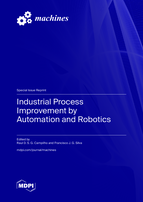Industrial Process Improvement by Automation and Robotics
A special issue of Machines (ISSN 2075-1702). This special issue belongs to the section "Automation and Control Systems".
Deadline for manuscript submissions: closed (10 June 2023) | Viewed by 36434
Special Issue Editors
Interests: advanced manufacturing systems; automation and robotics; industrial design
Special Issues, Collections and Topics in MDPI journals
Interests: tribology; coatings; manufacturing processes
Special Issues, Collections and Topics in MDPI journals
Special Issue Information
Dear Colleagues,
The efficiency of industrial processes is vital for the competitiveness of a company in the global market. A given process must ensure the desired quality, production flexibility to adapt to new product references, a high production rate, and have competitive fabrication costs. The evolution of industrial processes is directly linked to the need for mass production, and modern assembly techniques enable significant improvements in production volumes.
Throughout time, automation and robotics have become the best way to achieve the goals required by the market. Therefore, these technologies present themselves in a continuous evolution, constantly presenting new solutions. As a result, it is possible to undertake production increases, tight deadlines, and the required quality increase, making automation and robotics fundamental to the improvement process and the main allies of any producer.
The availability of software, such as simulation packages and offline programming systems, can test robotic applications, reduce engineering time and risk, and result in easier and cheaper programming. The development of Industry 4.0 has greatly spread the use of industrial robotic/automation systems, even in small companies, leading to new ways of production, value creation, and real-time optimization.
This Special Issue intends to bring together a significant number of good contributions in this area through high-quality original works in the field, subsequently promoting its dissemination through the open access system.
Prof. Dr. Raul D. S. G. Campilho
Dr. Francisco J. G. Silva
Guest Editors
Manuscript Submission Information
Manuscripts should be submitted online at www.mdpi.com by registering and logging in to this website. Once you are registered, click here to go to the submission form. Manuscripts can be submitted until the deadline. All submissions that pass pre-check are peer-reviewed. Accepted papers will be published continuously in the journal (as soon as accepted) and will be listed together on the special issue website. Research articles, review articles as well as short communications are invited. For planned papers, a title and short abstract (about 100 words) can be sent to the Editorial Office for announcement on this website.
Submitted manuscripts should not have been published previously, nor be under consideration for publication elsewhere (except conference proceedings papers). All manuscripts are thoroughly refereed through a single-blind peer-review process. A guide for authors and other relevant information for submission of manuscripts is available on the Instructions for Authors page. Machines is an international peer-reviewed open access monthly journal published by MDPI.
Please visit the Instructions for Authors page before submitting a manuscript. The Article Processing Charge (APC) for publication in this open access journal is 2400 CHF (Swiss Francs). Submitted papers should be well formatted and use good English. Authors may use MDPI's English editing service prior to publication or during author revisions.
Keywords
- automation
- robotics
- sensor and actuators
- flexible production
- mechatronics
- industry 4.0







